by todd | Feb 17, 2015 | World's Best Rock Climbing Areas
Buy or rent Tony’s City of Rocks rakkup guidebook
here and save over 30% versus purchasing from within our app via Apple or Google. It’s exactly the same guidebook, but offered at a lower price on
rakkup.com.
New York is not the City!.. every climber knows that.
Heralded by sport, trad, and even gym climbers as one of North America’s premier climbing venues… this place is loved by all.
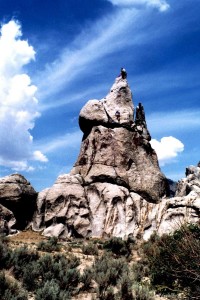
Climbers on the uniquely shaped Chicken Rock – City of Rocks Climbing
The bizarre shapes of every rock beg to be named… “It’s a chicken.” “No. It’s a Scottish Terrier. See the snout and tail?” This place could have been the backdrop to a Dr. Seuss book. The more time you spend in the City, the more confusing the names become. There are 2 or 3 names for most rocks here.
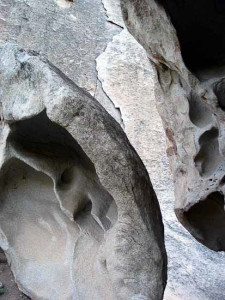
Unique climbing hold shapes in City of Rocks
It took over 100 years and the government stepping in to finally settle on a name for the whole place. Silent City, Circle City, Ancient City, Rock City, Goblin City, City of Castles, City of Rocks, Valley of Rocks, Rock Basin, Chapel Rocks, Monumental Rocks, and Pyramid Circle were among the many names commonly used by everyone. In the end the government decided on the most generic sounding one of the bunch. But “Silent City” was actually the most widely used by visitors. One starry night here and you will know why.
A trip to the City is more than just a climbing trip. It is a camping trip. And any veteran will tell you how delightful the camping is here. It is convenient car-camping among the very rocks you came here to climb on. You won’t be crammed like a sardine in a noisy, paved loop. Most sites are relatively private and have nearby toilets.
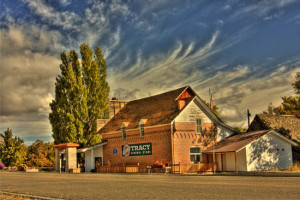
Tracy’s General Store Built Circa 1900 – City of Rocks Climbing
A trip here is a step back in time… geologically, culturally, and technologically. The fenceposts are tree limbs. The road is dirt. The signs are wood. The water comes from a well. And cell phone coverage is spotty. Good thing your rakkup guidebook app doesn’t need it.
The California Trail runs straight through the middle of the Reserve. If you think this place is bustling now, you should have seen it in 1852 when over 52,000 people pushed handcarts and 1,000,000 animals pulled wagons through here. You can still see the wagon wheel ruts and grease signatures they left behind.
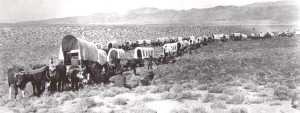
Wagon Train through City of Rocks circa 1855 – City of Rocks Climbing
Indian and emigrant legends mix with the tales of legendary climbers. Tony Yaniro climbed the still-unrepeated test-piece crack, “The Boogieman”. Greg Lowe tested the first spring-loaded cams in City cracks. And the City’s “Infinite” was widely regarded as the most difficult climb in the world at a time when difficulty was not measured solely by movement, but by the mental fortitude it took to lead a climb with little protection and no rehearsal.
The history of climbing in Idaho’s City of Rocks goes back to the early 1950s. It has been said the first thing to attract climbers here was the beautiful women. There is more than a grain of truth in that. Back then, in an effort to promote tourism, beauty contests were held on a stage set up on the west side of “Bathtub” Rock. Without a doubt some early first ascents were fueled by the angst of those pageants.
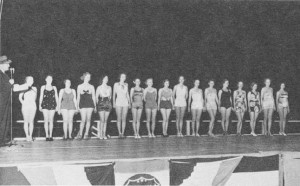
Beauty Contest at Bath Rock circa 1950 – City of Rocks Climbing
That may have been the initial impetus that brought strong men here. But beauty pageants are a thing of the past. Climbers of both sexes come here in droves now. Clamoring for holds they can wrap every digit around. The wildly gymnastic moves on the handlebar holds of routes like Colossus (5.10) take center stage on the back side of Bath Rock now. The shape of these holds defies everything our minds consider when we think of granite. No glacier polish. No featureless cracks. No oceans of holdless slab.
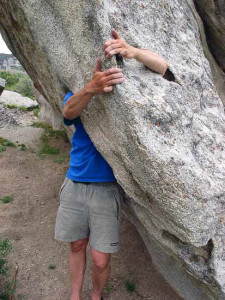
Big climbing holds at City of Rocks
Tony’s new City of Rocks rakkup guidebook describes 200+ more routes than any other guide ever has. Nearly 1,000 routes in all and more updates are on their way.
Learn why you can trust Tony’s beta
here.
by todd | Jan 21, 2015 | World's Best Rock Climbing Areas
Buy or rent Tony’s Litte Cottonwood rakkup guidebook
here and save over 30% versus purchasing from within our app via Apple or Google. It’s exactly the same guidebook, but offered at a lower price on
rakkup.com.
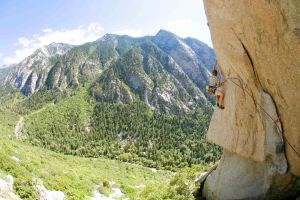
Scott McLeod on To Air is Human (5.10+), Gate Buttress, Photographer: Andrew Burr
Little Cottonwood rock climbing is northern Utah’s premier climbing venue, located within the Wasatch-Cache National Forest along the eastern border of the Salt Lake Valley where the Rocky Mountains meet the Great Basin, 15 miles from downtown Salt Lake City.
You won’t be doing the same move over and over again here. Low angle, high angle, overhangs, pockets, slabs and giant chimneys. Finger, hand and off-width cracks. Even the protection varies. Lube up the sliding nuts and 4” cams. Your micronuts and tube chocks will be shiny no more. This granite will eat them all up. Put your quickdraws on the same rack. There are over 200 sport routes here. Mostly limestone and quartzite. The list of 800, mostly granite, traditional routes is growing with constant updates to the app. The app includes closeup pitch by pitch photos of over 300 multi-pitch routes as high as 1,500 feet long. Over 1,000 routes in total, from 5.3 to 5.13. Check your ego at the trailhead. Little Cottonwood difficulty grades have a deserved reputation for being “full value”.
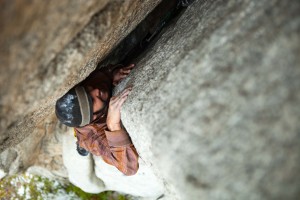
Zac Robinson on Cashmere Crack (5.11+), Lizard Head, Photographer: Andrew Burr
Plans to quickly bump your way up through the numbers will promptly be thwarted. But an apprenticeship here will hone every skill at every level. Hand jamming, stemming, smearing, edging, mantling, lay-backing and high-stepping.
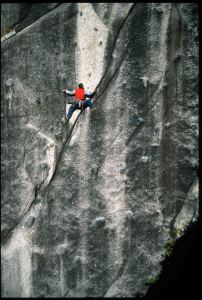
Luke Kretschmar on Disco Duck (5.10), The Waterfront, Photographer: Andrew Burr
Mastery of classic, so-called “beginner” routes will earn you the solid status of a true all-around rock climber.
Schoolroom (5.6) will prepare you for every size crack. Perhaps (5.7) will beat your lay-backing skills into submission. Crescent Crack (5.7) will teach you respect for chimneys. The lost art of nut placement will be within your grasp after a no cam redpoint of Pentapitch (5.8). The S-Direct (5.9) will test your mettle and give you pause to call yourself a 5.9 climber. Anyone who has climbed The Dorsal Fin (5.10+) comes away with a different perspective on the accomplishments of climbers throughout the ages.
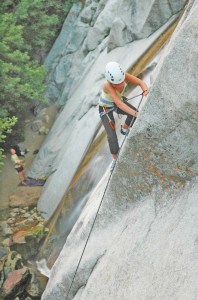
Breahnna Carrol on Fleeting Glimpse (5.9), Lisa Falls
These routes won’t just just force you to think. They constantly require you to re-think the way you climb. Routes are not simply sand-bagged. They just can’t be easily categorized by a number. The climbing is truly complex and frequently sustained at their grade. So-called “trick” maneuvers are commonplace. You won’t remember these routes by the number next to them. You will remember them by your experience. You will remember them by name.
Learn why you can trust Tony’s beta
here.
by rob | Nov 14, 2014 | World's Best Rock Climbing Areas

Joshua Tree NP, photo by Robert Miramontes
This week we are launching the rakkup digital version of Joshua Tree Rock Climbs by Robert Miramontes, from our partners Wolverine Publishing. This release is an emotional one for us on several levels and we thought it might be interesting to share the story of how it came to be. With a sense of great pride and accomplishment, gratitude for partners who helped us and believed in us, and sadness at a recent loss, we bring you this book and hope it is your companion for some great climbing days this Winter.
The good folks at Wolverine have been our most important partners for the last couple of years, and it all started with a visit to the Western Slope. We admired Wolverine as an early leader in smartphone versions of digital guidebooks, and we had recently seen the news that they were discontinuing the first generation of apps they had released because they proved to be difficult to update. Excitedly, we drove from Boulder to the Rifle area to pitch our platform. There we not only received the warm hospitality of Dave Pegg and his wife Fiona, but also the gift of their faith in us. After our meeting and a super home-cooked meal, they decided to entrust us to release digital versions of their books at a time when our catalog consisted of about two titles.
Some of you may have heard of the tragic loss of Dave Pegg last weekend. He was a great business partner but more than that. We counted him as a friend and admired his energy, business smarts, integrity, and pure love for the people and places of climbing. Several other authors told us his books set the standard in North America for detail, readability, and appearance, and we agree. Our last email from Dave was the “green light” to release the Joshua Tree guidebook we built together, and after we conferred with Robert Miramontes (its meticulous author), we agreed that Dave would want to see this go forward. Therefore we see this as something of a tribute to the beautiful books he made and the community of people he brought together to do it.
When you pick up the book, you are immediately struck by its beauty. The layout is clean and readable, the depth of the descriptions is amazing, the photos are simply among the most stunning of any guidebook (but also perfectly framed to help find your route), and the heft and thoroughness is mind-blowing. Turning this into a digital guidebook was a daunting task, but from the very first day that we prototyped rakkup’s turn-by-turn navigation we talked about Joshua Tree as “nirvana”, the ultimate place where it was really needed. We had already checked that GPS signal was accurate way out in the park beyond cell phone service.
It turns out, it took a team of four people and nearly six months from the time we started to pull it all together, and this book pushed our platform and our technologies to new heights. Todd was responsible for processing the original book files and using our automated import tool to parse all the sector, wall, boulder, and route descriptions and data. We structure the text and put it in a database so that climbers can quickly, sort, filter, and find routes. Our friend Tom Moulin helped with the enormous task of processing all the photos, preparing and labeling them to look great on mobile displays. (Tom is also a professional photographer, and author of the superb Southern Nevada Bouldering guidebook in his own right.) Robert, the author, used our web-based map building tool to draw a map of all the roads and trails that connect the 3,057 climbs and boulder problems with 201 miles of roads and trails. It boggles our minds to think of the time and knowledge required to put this together, and we feel sure every rakkup user is going to appreciate Robert’s setting this all down in a way we can benefit from when we climb. Watching Robert work forced us to make our tools better. I regret that some of the improvements will come too late to help this Herculean task, but I know all future map builders will benefit.
For my part, I found this guidebook was on such a daunting scale that I had to rewrite both the iPhone and Android versions of rakkup to give a better experience with it. First, we added smart downloads that let you open the guidebook and use it within about 15 seconds of your purchase, and seamlessly download nearly 600 photos in the background and as you need them. Once they are cached the entire guidebook works offline so you can use it anywhere in the park. Next up, I did a rewrite of the map drawing code to handle the complexity of the map, which includes over 5,300 sections of road and trail, 3 or 4 times as much as our next most complicated map. Both iOS and Android offer a way to break the drawing up into small units of work so you can zoom, pan, and tap and feel a responsive app even as we show you where all the climbs are. This requires us to do all the math of converting GPS coordinates into pixels, so it was a fun challenge.
Finally, I had to address the speed of route calculation. In our other guidebooks it felt nearly instantaneous to calculate the route from where you are to the route you seek, but it took a few seconds at J Tree on the iPhone app, and the Android app was just overwhelmed. Our algorithm was already pretty good, but I added a caching strategy to pre-calculate some things, and now we are back to instant response and reliable routing on both platforms. Along the way we used some new quality-control tools to validate the map and fix a few errors that crept into the map data, too.
This book was really what we had in mind three years ago when we labored to create rakkup. I love ability to filter a huge database of routes and see just the ones you want in a list or laid out on the map (by morning shade or afternoon sun, 3 or 4 stars, trad or sport or bouldering, just the right range of grades, and more). I can’t even imagine visiting Josh again without relying on rakkup navigation, as one who has been lost plenty and seen the labyrinth of stone in the park. And Robert’s beta, opinions, and ratings clearly seem to reflect more climbing experience there than I and my friends could ever hope to amass.
We loved being part of a team that came together to make a piece of work cooler than any of us could have done on our own. We got Wolverine’s permission to bring it to you at an amazing price. And we think that since we all rallied together around an effort started by Dave Pegg, it is a fitting tribute to how much he gave to the climbing community. You’ll be missed, Dave, and we will work hard to keep the level of quality you would have wanted, and to get out and climb as often as we can, as you certainly did.
-Rob, November 2014
by rob | Nov 9, 2014 | Uncategorized
Todd and I woke up to the sad news of the passing of Dave Pegg this morning. We still don’t know much but we’re saddened and took time to share memories with each other today.
Dave was the energy and the soul of Wolverine Publishing, and probably did more to raise the standard for North American climbing guidebooks than anyone in memory. The work he did helped thousands of climbers have happier climbing days and influenced many other authors who told us straight up that Wolverine’s work set the bar for them.
Todd and I met Dave and Fiona less than two years ago at their home near Rifle, when rakkup was in its infancy. They were among the very first to believe in us and put their trust in us, and Dave was a great partner to work with. He was honest and conducted his work with integrity, and he did what he said he would do. This is a rarer quality than some might think, and we valued it. He had vision for the future but tempered with the practicality he needed to make the present work.
But beyond that, we had a great admiration for Dave because he made time to do the things he loved, most especially climbing, and always seemed to be in the places and around the people he loved most, with a smile on his face. He worked hard and played just as hard.
Wolverine was pretty much the first to have apps for their guidebooks, way ahead of their time. We jumped at the chance to meet and earn the opportunity to build on the incredible library Wolverine had accumulated. Todd and I drove across the state of Colorado for a meeting and in the process got to enjoy hospitality and make new friends. On a later visit, we got to visit Dave’s new somewhat secret new crag and watch him work on his project of the day. He was clearly in his element and it was a beautiful thing to watch.
We will miss him and share condolences with all who feel this loss. If there’s anything we can to do preserve and build on the legacy that Dave created, we will give it our all as he would have.
-Todd and Rob
by todd | Nov 9, 2014 | World's Best Rock Climbing Areas
Buy or Rent Tod’s Devil’s Head rakkup guidebook
here and save over 30% versus purchasing from within our app via Apple or Google. It’s exactly the same guidebook, but offered at a lower price on
rakkup.com.
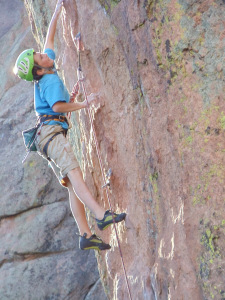
A young Gordy on Like Father Like Son – 5.12d – Passageway Wall, Devil’s Head Rock Climbing
Colorado has dozens of great climbing areas, but Devil’s Head seems to be the best kept secret among the less well known crags. With the route count closing in on 1000 and free camping all within an hour of downtown Denver, chances are we’ll be seeing a lot more climbers down there in the years to come. The addition of many new crags to the east and west of the previously known areas has nearly doubled the previous route count in just four years. Additionally, there have been new routes on what’s historically been known as Devil’s head Rock, deep on the Jackson Creek side that are much longer than any of the previous climbs.
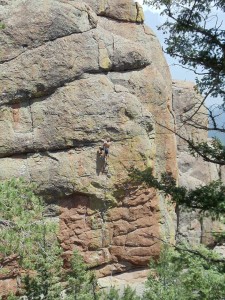
Tod Anderson on Devil’s Own Stone 5.11d – Devil’s Gate, Devil’s Head Rock Climbing
Probably the best thing about Devil’s Head besides the quality of the climbing is the feeling of remoteness, while being just a short distance from both Denver and Colorado Springs. The great views in all directions provide a hard to beat ambience compared to all of the other nearby areas like Clear Creek and Boulder Canyon. With about a half dozen different access points it’s possible to set up camp & hike directly from camp to many of the crags. No need to drive hours from Denver to find great camping and climbing, its right there in the back yard.
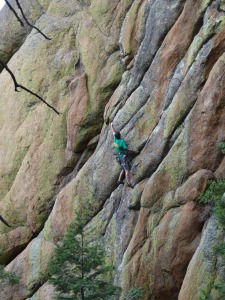
Gordy on Dances With Hummingbirds – Technicoulior Wall, Devil’s Head Rock Climbing
What makes Devil’s Head unique is the highly featured, fine grained granite found all over the mountain. This great stone allows a wide variety of climbing styles, making each crag and each route different. Unlike many granite areas, Devil’s Head has plenty of steep walls loaded with 5.12s & 5.13s, sometimes right next to lower angle crags with 8s, 9s & 10s. There are plenty of positive, incut holds to choose from on most routes in contrast to the usual granite dome slabbiness.
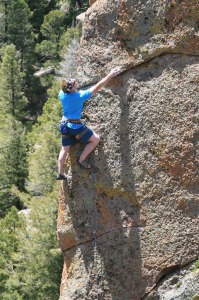
Derek Lawrence on Natty Dread 5.11a – Split Fin, Devil’s Head Rock Climbing
Recent exploration has produced a ton of new routes as featured in the November 2014 Rock & Ice article that showcases some of the best of the best new crags like Devil’s Gate, the Switchblade and Recovery Wall. More multi-pitch climbing has been added too on Devil’s Head Rock over on the Jackson Creek side with several five pitch routes and some that may go eight pitches in length. Revelation at 5.11, and Sunny Side Up at 5.10 top the list of the new longer routes that can be done with just a rack of draws. The intense patina features of Devil’s Gate make it a sought after destination for 5.11 to 5.13 climbers, with a high concentration of four star routes on impeccable stone. Over to the north, the rope stretching pitches on the Switchblade have been popular too and with a southern exposure sheltered from the wind it’s usually climbable on chillier days in the spring and fall.
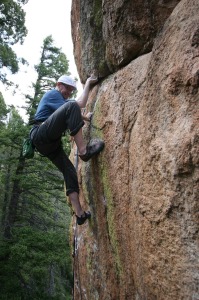
Tom Rossbach on Megalodon – 5.11d – Shark’s Fin, Devil’s Head Rock Climbing
Somewhere between 50 and 100 routes go in each year, so a rakkup app is the only way to keep up with the latest developments. The maze of spires, ridges and valleys is much easier to navigate the first few times with the GPS capability of rakkup too as opposed to getting lost in the woods. Whether you’re on a road trip from far away or a Colorado local, the best granite sport climbing in the US is right there waiting for you.
Learn more about Tod Anderson
here.
by todd | Nov 4, 2014 | World's Best Rock Climbing Areas
Buy Climb Morocco’s Ain Belmusk rakkup guidebook
here.
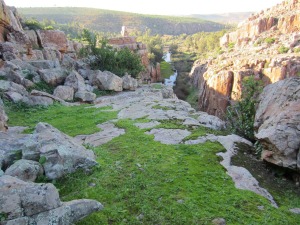
Solid marble quartzite sport climbing nestled in a climbing oasis 1.5 hours outside Marrakech. Welcome to Ain Belmusk.
Picture this: tranquil village location, quiet spring of water flowing by, green leaves lightly waving in the breeze, all setting up the stage for some fantastic single pitch cragging on unique rock in an exotic country…and oh yeah, don’t forget having this small climbing paradise all to yourself. If that interests you, I have just described one of Morocco’s small climbing treasures, Ain Belmusk. Located about 1 1/2 hours from Marrakech, Ain Belmusk offers a memorable day trip from the busy city and invites you to see and experience a side of Morocco that most visitors never see. You quickly move from highway, to an adventurous dirt road through villages, and with a five minute approach, you are at the base of numerous inspiring routes ranging from 5.8 up to 5.12a.
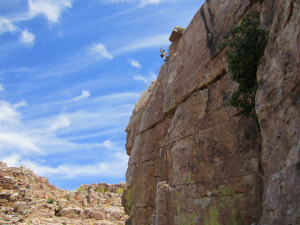
Jay Parks nearing the top of Solar 5.10c/d.
Ain Belmusk is home to some of the best single pitch sport climbing near Marrakech and also offers opportunities for new routing and single pitch trad climbing. Ain Belmusk is one of the original climbing areas developed by the French Alpine Club and be warned, some routes are a bit sandbagged. But fear not, you will not be disappointed with the remarkable routes Ain Belmusk has to offer. With the exception of an occasional shepherd sighting, or a village passerby, you will most likely have the climbing site all to yourself…no lines, no hassle. Just peaceful Moroccan tranquility…it’s magical. There is top access to almost every climb which is nice if you would prefer to top rope and get a feel for the area. And there are fun climbing options on both sides of the small spring offering climbing in both the sun and shade.
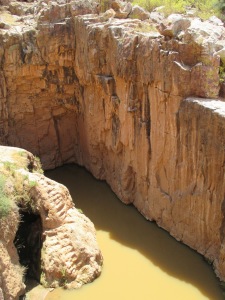
After ticking off your projects, cool off in the swimming hole.
Finding Ain Belmusk can be a bit tricky, especially for first time visitors, which is why the rakkup Ain Belmusk guide is so incredibly helpful utilizing the turn by turn gps technology. Ain Belmusk has been home to many of my personal climbing projects over the last couple of years and has provided me a nice break from the hustle and bustle of Marrakech. There is nothing better than walking in to Ain Belmusk early in the morning, watching the light slowly paint the rock as you rack up and set off on your first route of the day. This is a must climb location for anyone looking to get their rock fix for a day or two while on holiday in Marrakech.
Jay is a partner and co-founder of Climb Morocco. Learn more about Jay
here.
Jeremy is a partner and co-founder of Climb Morocco. Learn more about Jeremy
here.
by bgsimmons | Oct 26, 2014 | World's Best Rock Climbing Areas
Buy or rent Grant’s Acadia Rock Climbs rakkup guidebook
here and save over 30% versus purchasing from within our app via Apple or Google. It’s exactly the same guidebook, but offered at a lower price on
rakkup.com.
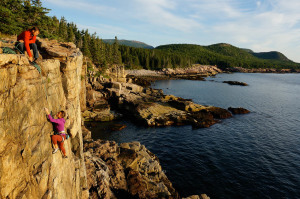
As dreamy as it gets. Ryan Scott and Cecilia Thomas enjoying a perfect morning at Otter Cliffs. Photo by Grant Simmons.
When most think of climbing in Maine, they think of Acadia. Specifically, they probably think of Otter Cliffs, that wonderful bit of golden rock that juts seaward from the most iconic stretch of the state’s coastline. And it’s obvious why: a 3-minute walk from the parking lot leads to a gorgeous and expansive terrace perched above nearly 70 different climbs. From here it is an easy rappel down to the base ledge, a momentary space out as you chalk your hands and stare out to the lobster buoys that bob so hypnotically, and boom, you are climbing – in paradise. This is what makes Otter Cliffs so special, so iconic, so classic. So idyllic and dreamy.
Make no mistake, though, there is much more to Acadia’s climbing than Otter’s pleasant topropes. Take, for instance, the South Wall, a cliff whose rock quality rivals anything in the East and whose cracks, corners, and slabs offer quintessential granite climbing. Or what about Great Head? Sure, that spot might require a few tricks here and there, and true, it isn’t the most friendly to beginners, but those who venture there are constantly blown away by the power and majesty of one of the nation’s tallest sea cliffs. There’s also the South Bubble, a cliff that offers family-friendly slabs, airy cracks, and perfect routes for the budding, mulitpitch climber. And these are just the cliffs that are currently included in the rakkup version of Rock Climbs of Acadia.
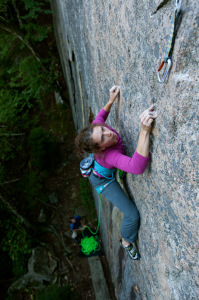
Hanna Lucy on the Canada Cliffs classic, House of Detention (5.11d). Photo by Vincent Lawrence.
Tucked between the island’s mountains are many more climbing areas that will be included in next season’s update of the digital guide. One of the best is Canada Cliffs; a cozy crag nestled amongst huge, fern-covered boulders that boast nearly 40 climbs. With fairly convenient top-access for many of it routes and a nice selection of bolted lines, this is an accessible area for many climbers and offers something new to those climbers who have been visiting the island for a long time.
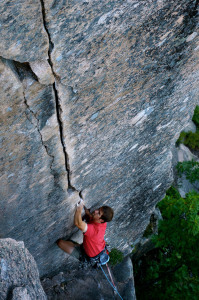
Seth Petit getting into the dreamy locks of Emigrant Crack (5.10b), South Wall. Photo by Grant Simmons.
This time of year, as summer winds down and fall settles in, fewer and fewer climbers are seen at the cliff. Those that are here shift away from the seaside summer havens of Otter Cliffs and Great Head and move inland to the South Wall, where the rock feels so perfectly crisp that the climbing feels easy and eloquent. On the wall’s perfect belay ledges, eyes glance out across the tree’s colorful canopies to the horizon, where the blues of the skies merge with the blues of the seas, and it hits you – this is truly an island paradise.
Buy Grant’s Rock Climbs of Acadia rakkup guidebook and pay less than in app here.
by todd | Sep 11, 2014 | World's Best Bouldering Areas
Buy Aaron’s Grayson Highlands Bouldering rakkup guidebook and save more than 30% over the Apple & Google in app price
here. Learn more about why you can trust Aaron’s bouldering beta
here.
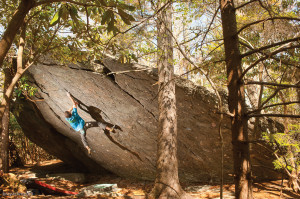
Aaron Parlier on Flying Spaghetti Monster (V7), Olympus Boulder
Grayson Highlands State Park (GHSP) has been called a tonic for the mind, body and soul. I have heard this sentiment offered by a number folks who love the outdoors but have never avidly climbed, and it accurately describes the scenery that envelops anyone, climber or not, who visits the Appalachian Highlands of Virginia. Cascading mountain streams, lofty boreal forests of spruce and fir, fall foliage showing fiery sugar maples and dancing yellow big toothed aspen, wild ponies, expansive mountain top balds, high elevation bogs, and foggy morning hollows (read “hollers”) are just a few of my favorite attributes of this region of Virginia. The 1000 boulder problems scattered throughout GHSP make this place yet another reason to return, season after season.
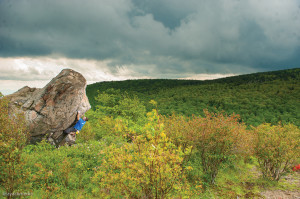
Matt Bieljeski on Foot Kaput (V4), Lonely Boulder
With elevations ranging between 3,500 and 5,089 feet, and being at a more northern latitude than other Southeastern bouldering areas, GHSP is without question the best summer bouldering in the Southeast. It isn’t only due to the high-northern Appalachian aspect of Grayson that allows for wonderful summertime sends. The very nature of the boulders adds to this. GHSP boulders are steep (VERY steep) with shaded overhangs leading to -usually- juggy topouts. Bouldering in Grayson Highlands is frequently a powerful, fingertip oriented, 45 degree affair. Vertical or slabby boulders are quite rare. Atypical Grayson holds are in-cut crimps and flakes (it is unusual to find a crux move involving a fiction dependent sloper). Once most Southeastern boulderfields become too humid, overgrown, and bug infested, GHSP thaws out from the icy winter as the spring season kicks into high gear.
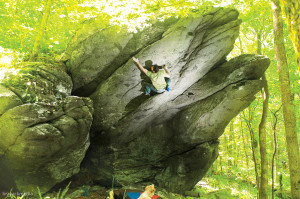
Dan Brayak on Moon Light Sonata (V3), Moon Light Boulder
Spring conditions are great in Grayson to be sure. Summer bouldering in GHSP is as good as it gets in the Southeast, but fall, as with every other Appalachian boulderfield, is the crown jewel for perfect projecting. Adding to the awesomeness of fall conditions, GHSP has without-a-doubt the best fall foliage in Virginia (and the literal bus loads of “leafer” tourists stand as testament). Crisp conditions, beautiful golden and red colors surrounding, and hundreds of boulder problems within a few minutes of the parking lot tend to spoil visiting climbers. With grades currently spanning from V0 to V12 (one boulder housing every grade from V2-V12), and with hikes ranging from 45 seconds to 30 minutes, what’s not to love?
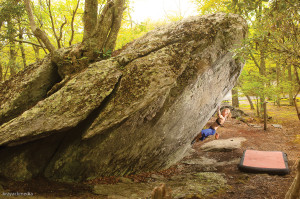
Julia Statler on Indian Outlaw (V3), Picnic Area Rockhouse Boulder
Bouldering in Grayson Highlands unofficially began in the early 1990’s with clandestine sessions at outlier boulderfields by the likes of James Litz and several others out of North Carolina, Tennessee, and Virginia. The total number of boulder problems likely didn’t exceed 200 until secure access and official approval of GHSP bouldering was gained in 2008-2009. Since then, open communication between climbers and park staff, careful development regarding recreational impacts and the park’s rare plant species, and volunteerism towards construction of approved access trails has opened many new GHSP boulderfields. The 1000th boulder problem was climbed in 2014. Now, with the full color Grayson Highlands Bouldering Guidebook and Rakkup’s mobile guidebook app, these wonderful areas, boulders, and problems in the most scenic section of Virginia’s Appalachian Mountains are even more accessible.
by cjkalman | Aug 19, 2014 | World's Best Rock Climbing Areas
You don’t get too many visitors from out of state here at Index. After all, why would you? This is Washington – the rainiest state in the lower 48; and Index lies right smack dab in the middle of the wetness. It must always be raining there, right? Right…
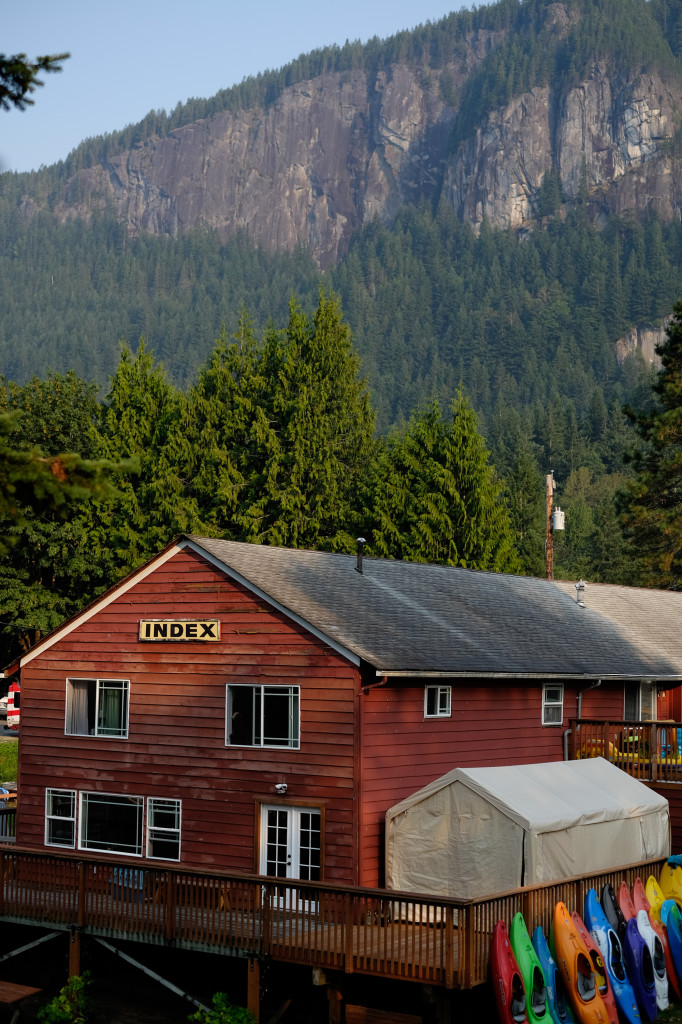
Index, the world’s best rock climbing? The towns walls lie within walking distance of the little hamlet of Index, WA. Photo Credit: Matt Van Biene
For those of you who still don’t know, the secret of America’s best crag is pretty well out of the bag. Index is, meter for meter and inch for inch, one of the densest concentrations of high-quality granite sport and trad routes in the U.S., or anywhere, for that matter. The climbing is unique and distinct; the weather is persnickety, but when it’s good it’s perfect; the surrounding views of some of the Cascade mountains’ most jagged peaks is breathtaking; and the rock quality is out of this world. Imagine a hybrid of knobby Tuolumne faces, mixed with parallel-sided Yosemite Valley cracks, all with the texture of New River Gorge nuttall sandstone. The combination is mind-bending: Index features knobs, pockets, crimps, jugs and slopers; seams, finger, hand, and offwidth cracks; stem corners, bomb-bay chimneys, friction arêtes, compression problems, and bouldery sequences; routes from 40 to 700 feet… and much more. In short, it’s about as good a place as any to learn how to free climb (there are also aid routes up to A4 – did we mention Index climbers were the first to do a hammerless ascent of El Cap?). Add to that a short approach, an abundance of 4 star routes from 5.9 to 5.13, and a tendency towards safe fall potential above gear of any size (or bolts), and you have all the makings of a crag so good that God, Yaweh, Allah, or whatever you want to call the Great Gig in the Sky, would climb there him or herself.
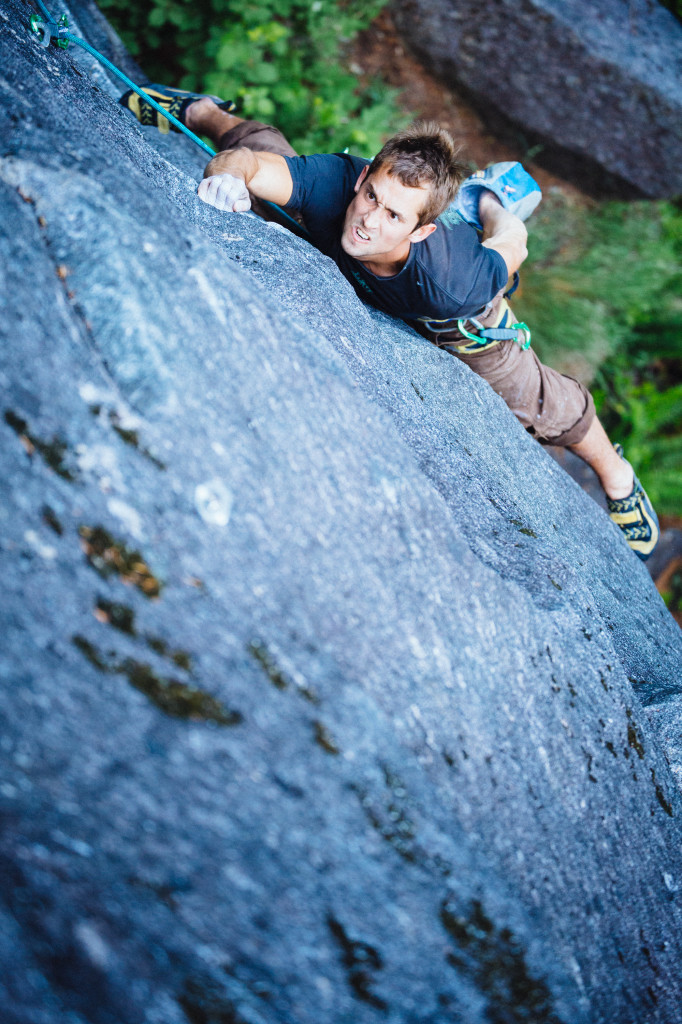
Michal Rynkiewicz won’t be forked off Spooner (11d) Index, WA, World’s Best Rock Climbing. Photo Credit: Matt Van Biene
But what really makes Index amazing is how it just seems to avoid all the climbing traffic that more popular destinations suffer from. Granted, it does not feature the quantity of routes that nearby Smith Rock sports. Nor is it as extensive or tall as Squamish, just a few hours North. Those two little gifts of climbing meccas seem to keep the masses away from Index, as most visitors to the Pacific Northwest will choose one, or the other, or both – but rarely what’s in between. Index locals couldn’t be more pleased. Part of what makes Index special is how rarely you need to wait in line for any route at all.
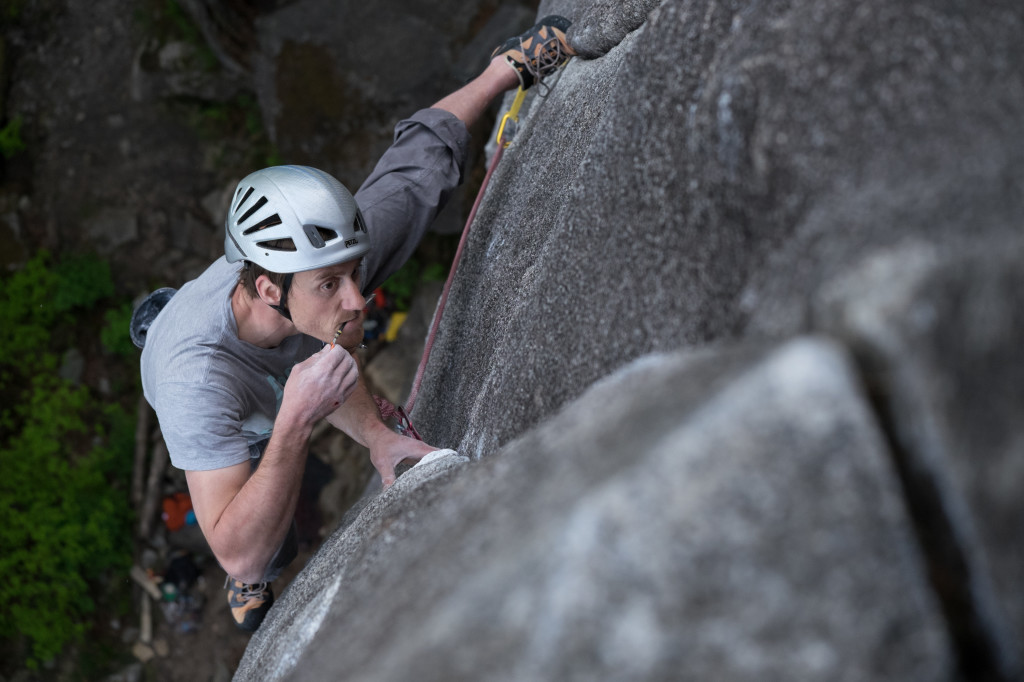
Dave Burdick aims to protect the crux of Japanese Gardens. Index WA, world’s best rock climbing. Photo Credit: Matthew Van Biene
For those who do make the pit stop off at the sleepy little town of Index, you’re in for a treat. If you climb 5.6 – check out Great Northern Slab. 5.7 or 5.8 – Senior Citizens in Space is hyperclassic. Godzilla may be the best single pitch of 5.9 anywhere. For 5.10, check out routes like Breakfast of Champions, Tattoosh, Davis-Holland / Lovin Arms, and Slow Children (no, Slow Children is NOT 5.11a – even if it feels like it’s 5.11c). 5.11 and 5.12 climbers get the most fun at Index, where the two grades encompass everything from roughly 5.11a to 5.13b at “normal” crags. The biggest concentration of routes at Index lies in the 5.11 grade. If you can fathom 5.11c, Japanese Gardens may well be the best of that grade anywhere.
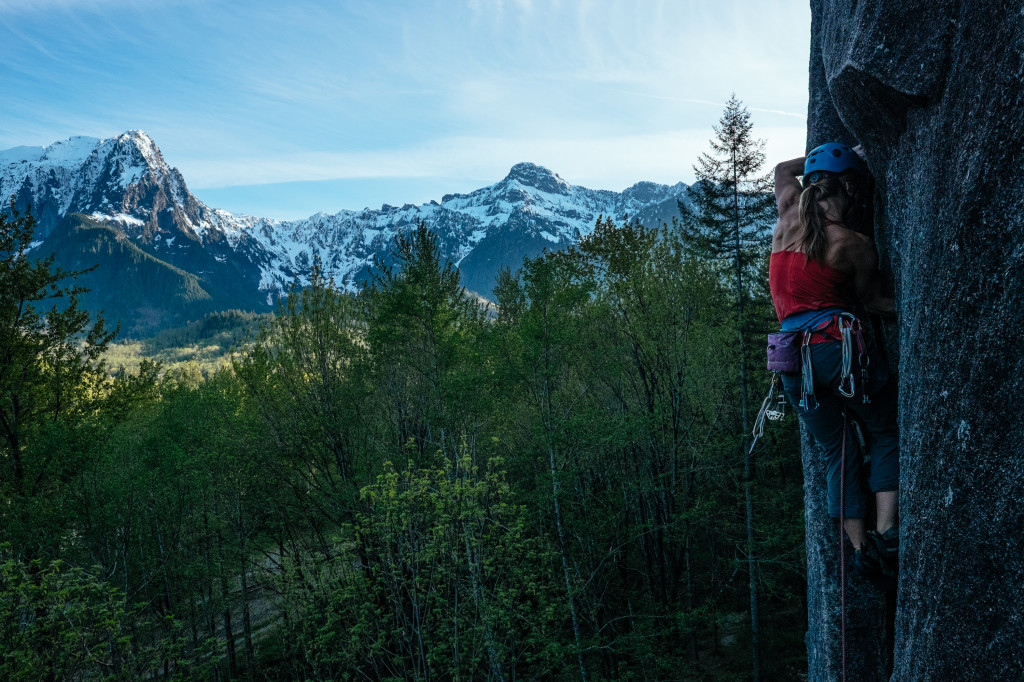
Jenny Abegg climbs Japanese Gardens as Mt. Index looks on. Index, WA, world’s best rock climbing. Photo Credit: Matthew Van Biene
The guidebook is 10 years out of print, but there’s a
brand new rakkup guide covering about a third of the routes, and growing every year! There are 4 star routes tucked away behind every corner, and shoved into each nook and cranny of this area – so it really helps to have a guide. If you don’t have a smart phone, ask a local. Chances are they’ll be so excited to see someone new they’ll take you under their wing for a day of unforgettable climbing at the state’s… I mean the country’s… I mean the WORLD’S best crag.
by rob | Jul 27, 2014 | World's Best Rock Climbing Areas
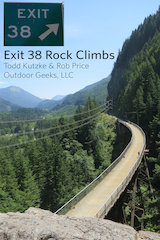 Todd and I have been climbing at Exit 38 now and again since the late 1990’s, and we know it’s a great resource for Seattle and Western Washington climbers. The drive out to North Bend is easy, and the crags stay cool and shady even on hot summer days. If you have ever been climbing at Exit 38, you know that it’s got a great array of moderate climbs from 5.6 to 5.12 and some excellent first leads for the beginning outdoor climber. The short approaches and friendly bolting and equipping of the routes are added bonuses.
Todd and I have been climbing at Exit 38 now and again since the late 1990’s, and we know it’s a great resource for Seattle and Western Washington climbers. The drive out to North Bend is easy, and the crags stay cool and shady even on hot summer days. If you have ever been climbing at Exit 38, you know that it’s got a great array of moderate climbs from 5.6 to 5.12 and some excellent first leads for the beginning outdoor climber. The short approaches and friendly bolting and equipping of the routes are added bonuses.
Our friends at snovalleyrock.com (with whom we partnered to create the Exit 32 Rock Climbing title for rakkup last year) have a guidebook to the area, but its hard to find a copy this year and the new edition likely won’t be in stores in time for the summer climbing season. We thought this would be a great opportunity to showcase the advantages of digital distribution, so we set out to create a rakkup guidebook. You can buy the resulting Exit 38 Rock Climbs title now in our app or here on our website. Like all rakkup titles, it includes great mapping and our much-loved turn-by-turn directions to navigate you to every climb using the GPS in your smartphone.
We’ve included all the climbs at the most popular and highest-quality areas: the Substation, Write-off Rock, Nevermind Wall, Deception Wall, We-Did Rock, Hull Creek Wall, and Amazonia. We’ve even documented some climbs that have never appeared in any guidebook before. As always with rakkup, it’s fast and easy to search, filter, browse by grade, and map all the routes.
This was a fun project for us, as we took the opportunity to try some new technologies and teach ourselves some new tricks. We used some cool new Adobe software for iPads to sketch routes and annotate photos while standing right at the crag, and some cool “stitching” techniques to create panoramic views of some walls that would be impossible to take as a single image. As a result this guidebook features detailed color photos of the routes with clear lines making it easy to identify different routes. We think it’s the best guidebook yet for hassle-free climbing at Exit 38.
We’ve kept the price affordable and continue to offer an even less-expensive option to “rent” the guidebook for 2 months at half the usual price, if you aren’t a frequent visitor and just want to give it a spin. Happy climbing!













































 Todd and I have been climbing at Exit 38 now and again since the late 1990’s, and we know it’s a great resource for Seattle and Western Washington climbers. The drive out to North Bend is easy, and the crags stay cool and shady even on hot summer days. If you have ever been climbing at Exit 38, you know that it’s got a great array of moderate climbs from 5.6 to 5.12 and some excellent first leads for the beginning outdoor climber. The short approaches and friendly bolting and equipping of the routes are added bonuses.
Todd and I have been climbing at Exit 38 now and again since the late 1990’s, and we know it’s a great resource for Seattle and Western Washington climbers. The drive out to North Bend is easy, and the crags stay cool and shady even on hot summer days. If you have ever been climbing at Exit 38, you know that it’s got a great array of moderate climbs from 5.6 to 5.12 and some excellent first leads for the beginning outdoor climber. The short approaches and friendly bolting and equipping of the routes are added bonuses.